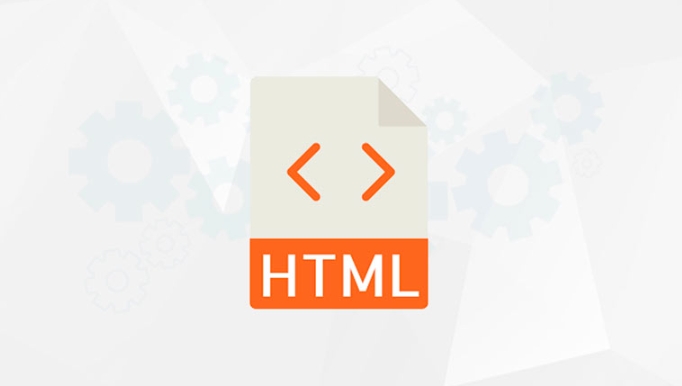Debugging the H5 page can be solved in three key points on the mobile side: 1. Use the remote debugging tool to connect the device through USB and use Chrome DevTools or Safari Web Inspector for remote debugging; 2. Process the console output on the real machine, encapsulate the log function and report it or provide user feedback; 3. Pay attention to mobile-specific problems, such as cache policy, UA differences and CSS compatibility, and need to add version numbers, unified UA and multi-device testing to ensure compatibility. Mastering these methods can significantly improve debugging efficiency.

Debugging the H5 page is actually more complicated than the desktop on the mobile side (iOS and Android), because there are limitations on the mobile browser environment and debugging tools. However, as long as you master a few key points, debugging is not that troublesome.

1. Use remote debugging tools
The most common way to debug on mobile is to connect the device over USB and then use Chrome DevTools or Safari Web Inspector for remote debugging.
For Android:
- Make sure the phone has "Developer Options" and "USB Debug Mode" enabled
- Connect the computer with a data cable, enter
chrome://inspectin the Chrome address bar - Find your device and running H5 page, click "inspect" to open the debug panel
For iOS:
- Turn on "Settings> Safari Browser>Developer Menu" on your iPhone
- Connect the device using Safari's "Development" menu (Safari on Mac needs to open the "Development" menu at the same time)
- Select the device and the current page to see information such as console, network requests, etc.
This method can cover almost most front-end debugging needs, including viewing DOM, executing JS, viewing network requests and performance analysis.

2. Process the console output on the real machine
Sometimes you can't debug with the computer all the time, or want to see what problems happen to the user in the real environment. At this time, you can collect the content of console.log or send it to the server for saving.
A simple way is:

- Encapsulate a log function and store log information into a global variable or localStorage
- Check whether there is an error log when the page is loaded, and if so, it will be automatically reported.
- You can add a button to allow users to copy log content with one click for easy feedback
For example, a piece of code:
window.logs = [];
console.log = function(msg) {
window.logs.push(msg);
// It can also be sent to the background};Although this method is simple, it is very useful without a debugger, especially when positioning the problem after it is launched.
3. Pay attention to problems specific to mobile terminals
Some problems only occur on mobile devices, such as:
- Caching problem : The caching strategy of mobile browsers is relatively radical, especially the built-in browser of WeChat, which often leads to the update of JS/CSS but does not take effect. The solution is to add a version number to the URL, such as
main.js?v=1.0.1 - UA judgment impact logic : Some H5 pages will be processed differently according to UA, but the UA of different apps has a large difference and is prone to errors. It is recommended to unify UA or print it out to confirm when debugging.
- Compatibility differences : iOS's Safari does not support certain CSS features well, such as
position: stickymay not take effect in the old version; Android WeChat browsers sometimes have strange performances in flex layout. It is best to test it several times on multiple devices
These problems may not be encountered every time, but once they encounter them, it is quite difficult to check them, so it is better to be careful at the beginning.
Basically, these methods are not too complicated, but they may get stuck if they are not familiar with them. If you master these skills, you won’t have too much headache when debugging the H5 page on your phone.
The above is the detailed content of How to debug H5 on iOS and Android?. For more information, please follow other related articles on the PHP Chinese website!

Hot AI Tools

Undress AI Tool
Undress images for free

Undresser.AI Undress
AI-powered app for creating realistic nude photos

AI Clothes Remover
Online AI tool for removing clothes from photos.

Clothoff.io
AI clothes remover

Video Face Swap
Swap faces in any video effortlessly with our completely free AI face swap tool!

Hot Article

Hot Tools

Notepad++7.3.1
Easy-to-use and free code editor

SublimeText3 Chinese version
Chinese version, very easy to use

Zend Studio 13.0.1
Powerful PHP integrated development environment

Dreamweaver CS6
Visual web development tools

SublimeText3 Mac version
God-level code editing software (SublimeText3)

Hot Topics
 Audio and Video: HTML5 VS Youtube Embedding
Jun 19, 2025 am 12:51 AM
Audio and Video: HTML5 VS Youtube Embedding
Jun 19, 2025 am 12:51 AM
HTML5isbetterforcontrolandcustomization,whileYouTubeisbetterforeaseandperformance.1)HTML5allowsfortailoreduserexperiencesbutrequiresmanagingcodecsandcompatibility.2)YouTubeofferssimpleembeddingwithoptimizedperformancebutlimitscontroloverappearanceand
 Adding drag and drop functionality using the HTML5 Drag and Drop API.
Jul 05, 2025 am 02:43 AM
Adding drag and drop functionality using the HTML5 Drag and Drop API.
Jul 05, 2025 am 02:43 AM
The way to add drag and drop functionality to a web page is to use HTML5's DragandDrop API, which is natively supported without additional libraries. The specific steps are as follows: 1. Set the element draggable="true" to enable drag; 2. Listen to dragstart, dragover, drop and dragend events; 3. Set data in dragstart, block default behavior in dragover, and handle logic in drop. In addition, element movement can be achieved through appendChild and file upload can be achieved through e.dataTransfer.files. Note: preventDefault must be called
 What is the purpose of the input type='range'?
Jun 23, 2025 am 12:17 AM
What is the purpose of the input type='range'?
Jun 23, 2025 am 12:17 AM
inputtype="range" is used to create a slider control, allowing the user to select a value from a predefined range. 1. It is mainly suitable for scenes where values ??need to be selected intuitively, such as adjusting volume, brightness or scoring systems; 2. The basic structure includes min, max and step attributes, which set the minimum value, maximum value and step size respectively; 3. This value can be obtained and used in real time through JavaScript to improve the interactive experience; 4. It is recommended to display the current value and pay attention to accessibility and browser compatibility issues when using it.
 How can you animate an SVG with CSS?
Jun 30, 2025 am 02:06 AM
How can you animate an SVG with CSS?
Jun 30, 2025 am 02:06 AM
AnimatingSVGwithCSSispossibleusingkeyframesforbasicanimationsandtransitionsforinteractiveeffects.1.Use@keyframestodefineanimationstagesforpropertieslikescale,opacity,andcolor.2.ApplytheanimationtoSVGelementssuchas,,orviaCSSclasses.3.Forhoverorstate-b
 HTML audio and video: Examples
Jun 19, 2025 am 12:54 AM
HTML audio and video: Examples
Jun 19, 2025 am 12:54 AM
Audio and video elements in HTML can improve the dynamics and user experience of web pages. 1. Embed audio files using elements and realize automatic and loop playback of background music through autoplay and loop properties. 2. Use elements to embed video files, set width and height and controls properties, and provide multiple formats to ensure browser compatibility.
 What is WebRTC and what are its main use cases?
Jun 24, 2025 am 12:47 AM
What is WebRTC and what are its main use cases?
Jun 24, 2025 am 12:47 AM
WebRTC is a free, open source technology that supports real-time communication between browsers and devices. It realizes audio and video capture, encoding and point-to-point transmission through built-in API, without plug-ins. Its working principle includes: 1. The browser captures audio and video input; 2. The data is encoded and transmitted directly to another browser through a security protocol; 3. The signaling server assists in the initial connection but does not participate in media transmission; 4. The connection is established to achieve low-latency direct communication. The main application scenarios are: 1. Video conferencing (such as GoogleMeet, Jitsi); 2. Customer service voice/video chat; 3. Online games and collaborative applications; 4. IoT and real-time monitoring. Its advantages are cross-platform compatibility, no download required, default encryption and low latency, suitable for point-to-point communication
 How to create animations on a canvas using requestAnimationFrame()?
Jun 22, 2025 am 12:52 AM
How to create animations on a canvas using requestAnimationFrame()?
Jun 22, 2025 am 12:52 AM
The key to using requestAnimationFrame() to achieve smooth animation on HTMLCanvas is to understand its operating mechanism and cooperate with Canvas' drawing process. 1. requestAnimationFrame() is an API designed for animation by the browser. It can be synchronized with the screen refresh rate, avoid lag or tear, and is more efficient than setTimeout or setInterval; 2. The animation infrastructure includes preparing canvas elements, obtaining context, and defining the main loop function animate(), where the canvas is cleared and the next frame is requested for continuous redrawing; 3. To achieve dynamic effects, state variables, such as the coordinates of small balls, are updated in each frame, thereby forming
 How to check if a browser can play a specific video format?
Jun 28, 2025 am 02:06 AM
How to check if a browser can play a specific video format?
Jun 28, 2025 am 02:06 AM
To confirm whether the browser can play a specific video format, you can follow the following steps: 1. Check the browser's official documents or CanIuse website to understand the supported formats, such as Chrome supports MP4, WebM, etc., Safari mainly supports MP4; 2. Use HTML5 tag local test to load the video file to see if it can play normally; 3. Upload files with online tools such as VideoJSTechInsights or BrowserStackLive for cross-platform detection. When testing, you need to pay attention to the impact of the encoded version, and you cannot rely solely on the file suffix name to judge compatibility.






